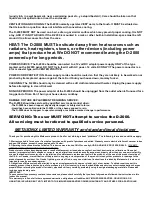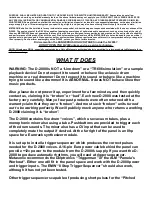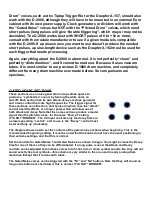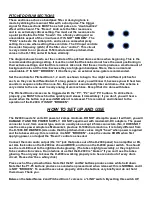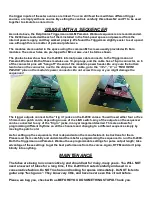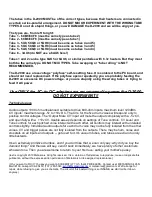
Drum” voices, such as the Tiptop Trigger Riot or the Doepfer A-157, should also
work with the D-2000, although they will have to be mounted in an external Euro
cabinet with its own power supply. Clock generators or dividers will work with
the “Gated Noise” voices but NOT with the “Pitched Drum” voices, which need
short pulses (long pulses will give “double triggering”, which may or may not be
desirable). The D-2000 works best with SHORT pulses of 0 to +5v or more;
consult with the module manufacturer to see if a given module is compatible
with the D-2000. If a pulse source you want to use doesn't produce the needed
short pulses, a pulse-length device such as the Doepfer A-162 must be used for
each trigger that needs processing.
Again, everything about the D-2000 is abnormal. It is not perfectly “clean” and
perfectly “distortionless”, and it cannot be made so. Because it uses vacuum
tubes. It is most similar to our previous D-1000 drum machine, and completely
different from any drum machine ever made before. So comparisons are
specious.
GATED NOISE SECTIONS
These sections use a noise generator and a pentode apiece to
produce a “cymbal-like” sound, by turning the white noise on
and off. Each section has its own attack-decay envelope generator
and a tone control that cuts high frequencies. The trigger signal for
these sections can either be a short pulse (in which case the “attack”
control has little effect), or a longer pulse which will allow use of
both attack and decay. Note that the noise sections produce a louder
signal than the pitched voices, for the same “Out vol” setting.
IT IS NOT “BROKEN”. The CV input controls only the decay time via
a slow-responding ”vactrol”, and to use it, the “Decay” control must
be turned fully up (clockwise).
The diagram shows how to set the controls of the gated noise sections when beginning. This is the
recommended beginning setting. It must be noted that the knobs do not have the usual positioning in
their extreme settings, and that this is normal.
Set the controls for Gated Noise 1 and Gated Noise 2 as shown to begin. You might increase the Decay
time for one of them so they can be differentiated. If a long pulse is used, the Attack and Decay
controls can be adjusted to turn these voices into hi-hat, ride or crash cymbal sounds. No, they will not
sound exactly like real cymbals—this scheme is very similar to the one used in early analog drum
machines. Except that it is done with tubes.
The Gated Noise voices can be triggered with the “N1” and “N2” buttons. Note that they will sound as
long as the buttons are held down; this is normal. IT IS NOT “BROKEN”.


